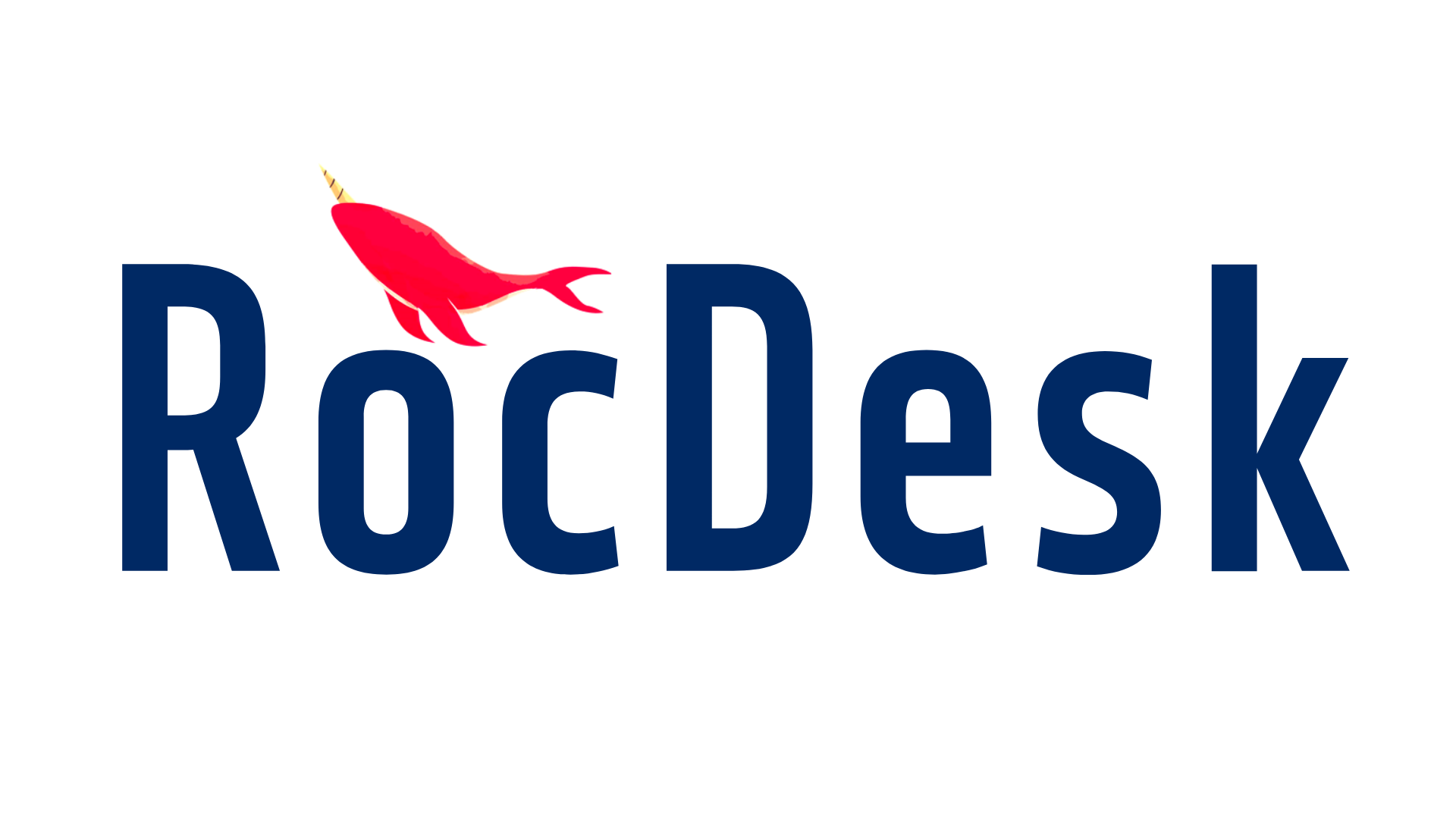Writing a LinkedIn summary is incredibly difficult — especially without examples to look at.

What should you put on your LinkedIn summary? A recounting of your prior roles? A list of your accomplishments? Should you write it in first person? Or in third?
Or should you forge ahead using the cookie-cutter bio LinkedIn wrote for you? (The answer to that question is no, but not to worry: You’ll soon have a LinkedIn summary you’ll be proud to publish.)
10 LinkedIn Summary Templates
In this blog post, we'll dig into what to include in your LinkedIn about section to make it stand out, as well as some examples to give you inspiration. Let’s get started.
LinkedIn Summary
The LinkedIn summary, also referred to as the LinkedIn bio or LinkedIn about section, is a few paragraphs of text that appears right before a LinkedIn user’s list of current and prior roles. LinkedIn gives a limit of up to 2,000 words, but only the first three lines are visible before a visitor has to click ‘See More.’
Writing LinkedIn summaries is especially hard for salespeople, marketers, and other professionals whose work relies on networking. You're not targeting recruiters and hiring managers; you're appealing to potential buyers and clients.
Plus, on top of finding an interesting and genuine way to describe your professional background, you must also come across as a subject matter expert.
Regardless, whether you’re a job seeker starting your search on LinkedIn or a tenured professional, your summary should speak to your skills, experience, and professional interests — think of it as your digital elevator pitch.
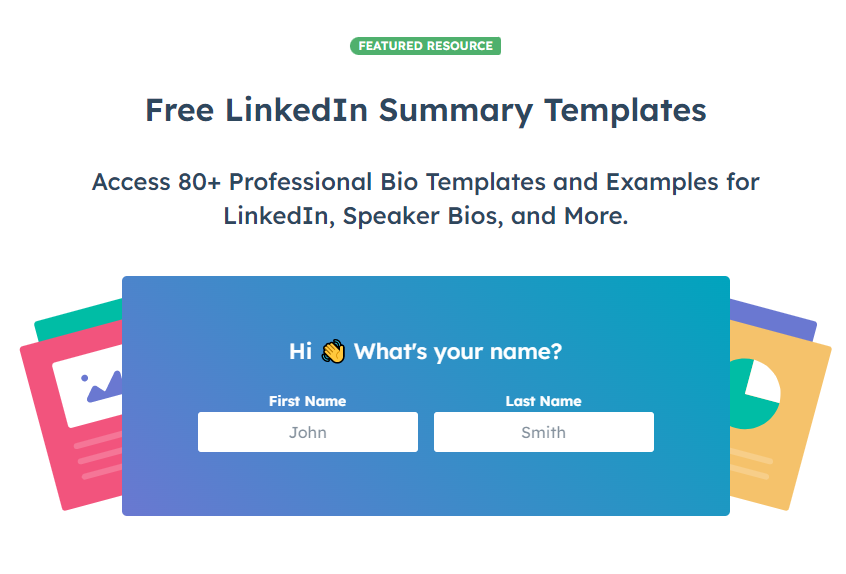
Why a Good LinkedIn Summary is Important
Writing a LinkedIn summary may feel like an unnecessary step — especially if you keep your profile up to date. You might also see it as unnecessary if you don’t spend a lot of time on the platform or aren’t looking for a job.
But a good LinkedIn summary is crucial for career success. For salespeople, it can be a handy tool for social selling; for other professionals, it could be the gateway to a new career opportunity.
Let’s go over the reasons you should most definitely write a LinkedIn summary.
1. You get to introduce yourself in your own words.
While your prior roles may be notable, they’re not the only things people should know about you. A LinkedIn summary will allow you to make a personable first impression and highlight your accomplishments and expertise in a succinct way.
2. You get to show your personality.
Add a little flair and humor, or keep it super professional. Either way, your LinkedIn summary will give recruiters and other users a taste of what they can expect if they reach out to you. It can also help recruiters gauge culture fit and help prospects and potential clients get a sense of whether they’d like to work with you.
3. You can rank higher in LinkedIn search results.
LinkedIn uses the about section in its algorithm, as well as your LinkedIn headline, current title, and other factors. By writing a keyword-rich LinkedIn summary, you can become more visible to potential prospects and recruiters in search results. If you include keywords such as “content,” “management,” and “analysis” in your bio, you may attract more views.
Ready to get started writing your LinkedIn summary?
How to Write a LinkedIn Summary
1.Create a quick outline prior to writing your about section.
2.Hook readers with a strong opener.
3.Tell the reader why you do what you do.
4.Speak to your industry expertise.
5.Call out your specialties and skills.
6.Provide data to back up your results and prove your expertise.
7.Mention if your team is currently hiring and invite people to apply.
8.Highlight your professional interests.
9.Include a call-to-action with your contact information.
10.Tip: Break up large blocks of text.
1. Create a quick outline prior to writing your About section.
While your LinkedIn profile isn't an academic essay, you should still outline the things you want to say and the order in which you want to say them.
The last thing your audience needs is long, rambling paragraphs with no clear progression from sentence to sentence.
Sticking to a predetermined structure will help you communicate clearly and concisely.
Consider following a format similar to this:
Hook: A sentence that makes the reader want to keep reading. Remember: only the first 3 lines are visible when a user enters your profile. With a hook, you ensure they click ‘See more.’
Mission: Tell the reader why you do what you do.
Expertise and Skills: Tell the reader what you’re good at.
Accomplishments: Show the reader how your expertise delivered results in the past.
Call to Action: Tell the reader what you want them to do after they’re done reading your summary.
If you’re not sure how to get started, use our free professional bio templates, which you can use to write your LinkedIn bio.
2. Hook readers with a strong opener.
The goal of the first sentence of your LinkedIn summary is to get your audience to continue reading. That's why it's important to pique their interest early and compel them to keep reading.
This tactic is called a hook.
You can hook readers with your LinkedIn summary by opening a loop that can only be closed with further explanation or making a claim so outlandish that it needs further justification.
Hook Example
"It took me more than X sales demos to learn the secret about Y, but since then, something unexpected has happened."
3. Tell the reader why you do what you do.
People connect with stories and values more than the straightforward "what you do.'' While the "what" is important, consider also including the "why."
Understand what has attracted you to your profession and what your mission is in your role. These will make your LinkedIn profile more emotionally resonant.
Mission Example
"I grew up on the Mississippi River and watched it get clearer over time as manufacturing standards improved. Since then, I knew I wanted to spread the word about sustainability in business environments."
4. Speak to your industry expertise.
Next, it’s time to bolster your mission with your industry expertise. Describe your background and qualifications in two-to-three sentences.
For example, are you a salesperson using LinkedIn to connect with prospects? Your summary should speak to your expertise in your industry, and your interest in helping people achieve results. Maybe you're a customer success manager using LinkedIn to connect with customers. Your summary should speak to your expertise in your industry and your availability for consulting.
Industry Expertise Example
"I have 7+ years of sales experience in both SDR and account manager roles."
5. Call out your specialties and skills.
After highlighting your expertise, tell us what you focus on in 1-2 sentences. For instance, if you’re a digital marketer, do you focus on SEO or social media?
If you recently graduated from college, did you study something specifically within your field?
Calling out your specialties is especially critical in sales. There are many types of sales jobs out there in a vast number of industries with an infinite number of buyer personas and markets. Whether your goal is to appeal to employers or prospects, be sure to call out the things you do well to attract the opportunities best aligned with your goals.
Specialties and Skills Example
"I’m a mid-market sales executive with experience in direct sales and SAAS product demonstrations."
6. Provide data to back up your results and prove your expertise.
It’s time to prove that you’re actually an expert by sharing important data points. No need to give prospective employers a laundry list of your accomplishments — that's what the section below is for — but it can be impactful to weave a few of your most impressive data points into your summary paragraph.
Proof Example
"Over the past five years, I've made it into the President's Club three times and my closed-won business has seen less than 10% churn during the first 12 months."
7. Mention if your team is currently hiring and invite people to apply.
This is optional, but it will serve you in several ways. First, it will show that you’re a team player, and second, it will show that you’re committed to both your professional growth and your current company’s growth.
It’s a must-have if you’re in the business of recruiting, as this can serve as an excellent recruiting tool. For example, are you a team manager using LinkedIn to recruit for job openings? Your summary should speak to the fact that you have openings, the type of work you do, and why a candidate would want to work at your company.
Team is Hiring Example
"We're currently hiring account managers for our Pacific Northwest territory. The ideal candidate has 5+ years of sales experience and a demonstrated familiarity with the region. We're a fast-growing team with no cap on commission. Click here to learn more and apply."
8. Highlight your professional interests.
Next, it’s time to highlight your professional interests. What do you help others do? What’s your goal in doing so? This is different from your skills in that it’s not necessarily as quantifiable or fact-driven. Because these are your interests, you don’t have to provide data to prove them.
Show that you’re committed to pursuing them and be sure to sound passionate about them.
Professional Interests Example
“I'm a sales coach that’s interested in assisting small teams (five-10 people) optimize their time and workflows so businesses can grow without adding more headcount and reps can advance their careers.”
9. Include a call-to-action with your contact information.
Last but certainly not least, include a call-to-action and potentially share your contact information. Are you a freelance or contract worker hoping to find more work on LinkedIn? Your summary should end with how to get in contact with you. If you want to seal the deal, include a list of your most impressive clients.
CTA Example
"Reach me at email@address.com or book time on my calendar here: [Calendar link]. Previous clients include [Your most impressive client], [Your second most impressive client], and [Your third most impressive client]."
If you’re not looking for more work, you can also simply end with, “Feel free to message me — I’d love to chat.”
10. Tip: Break up large blocks of text.
If you find your summary is on the longer side (which isn’t a problem as long as it’s compelling), try breaking up large blocks of text to make it easier to read. When initially viewing a profile, many people are scanning for high-level context. If you are posting long paragraphs, some of your notable highlights can get lost.
Try keeping your text blocks to two or three sentences max, making your summary easier to read and digest.
What to Put in a LinkedIn Summary
Depending on the goal of your LinkedIn profile, your LinkedIn summary should include 3-5 sentences that describe: your years of experience in your industry, your area of expertise, the types of organizations you've worked with, your skills, and what you're most known for professionally.
Think of your LinkedIn summary as your digital elevator pitch: In just a few sentences, it should give the reader a clear idea of who you are, what sets you apart, and what you're looking for from the viewer.
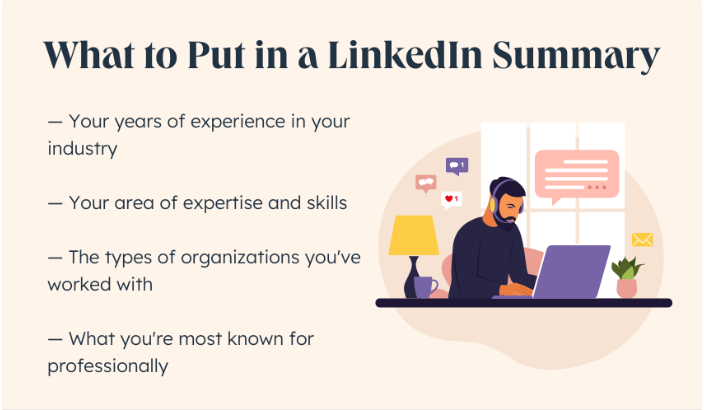
Here’s an example:
"I'm a sales rep dedicated to helping local Oklahoma City services businesses grow their customer base and decrease customer churn. I have 6 years of experience in local sales and I've consistently met and exceeded my quota throughout my career. Within the last year, I've topped our leaderboard six out of 10 months. On average, I close business 10% faster than my peers."
Now, let's discuss what to avoid when crafting your LinkedIn summary.
What (Not) to Put in a LinkedIn Summary
Cheesy or Cliché Terminology
Your profile should be free of terms such as "guru" or "master." These terms are highly subjective, and don’t speak to your actual skills or abilities. Instead of trying to be a self-proclaimed “guru,” share a tangible piece of work you’ve done that demonstrates your expertise, or describe a specific initiative where your work drove business results.
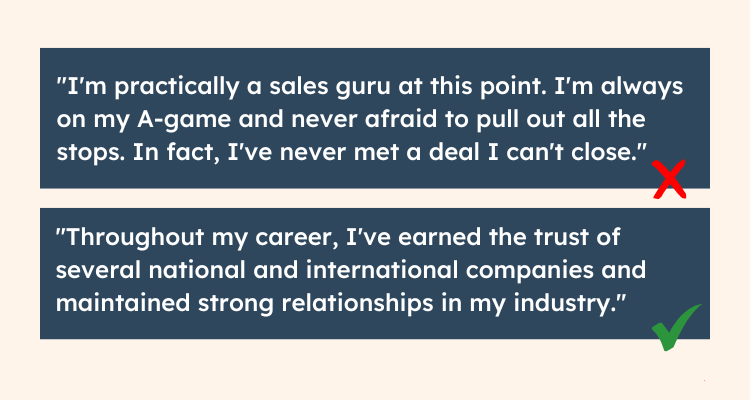
Your Resume
Avoid copying and pasting points from your resume to your LinkedIn summary. Not only is it redundant because your work history should be up-to-date on your profile, but recruiters and potential connections are looking for a brief introduction to who you are, not a regurgitation of your resume.
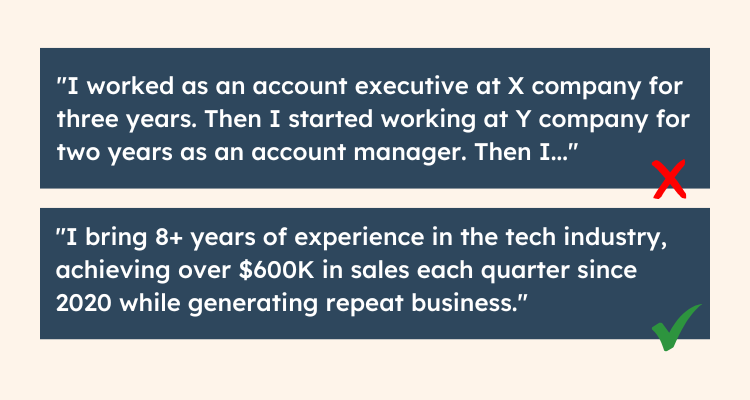
Spelling or Grammatical Errors
We’re all human, and spelling mistakes happen. Before publishing your profile, make sure you review it a few times to catch any misspellings or grammatical errors. Having typos on your profile can challenge your credibility, and can be a distraction from your positive attributes.
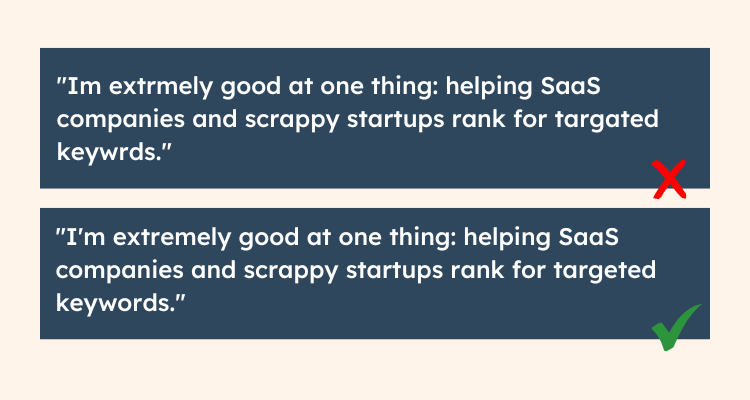
Your Full Life Story
LinkedIn summaries are not the place to publish your autobiography (though I’m sure your autobiography is lovely). If users are scanning your profile looking for relevant information pertaining to a role or opportunity, you want those points to be front and center.
When you update your LinkedIn summary, aim to include information that’s relevant to the jobs and opportunities you’re open to, and keep things clear and concise.

LinkedIn Summary Examples
If you need some inspiration, good news. These LinkedIn summary examples will help you find the right words.
1. This salesperson effectively demonstrates his passions and top competencies in the field.
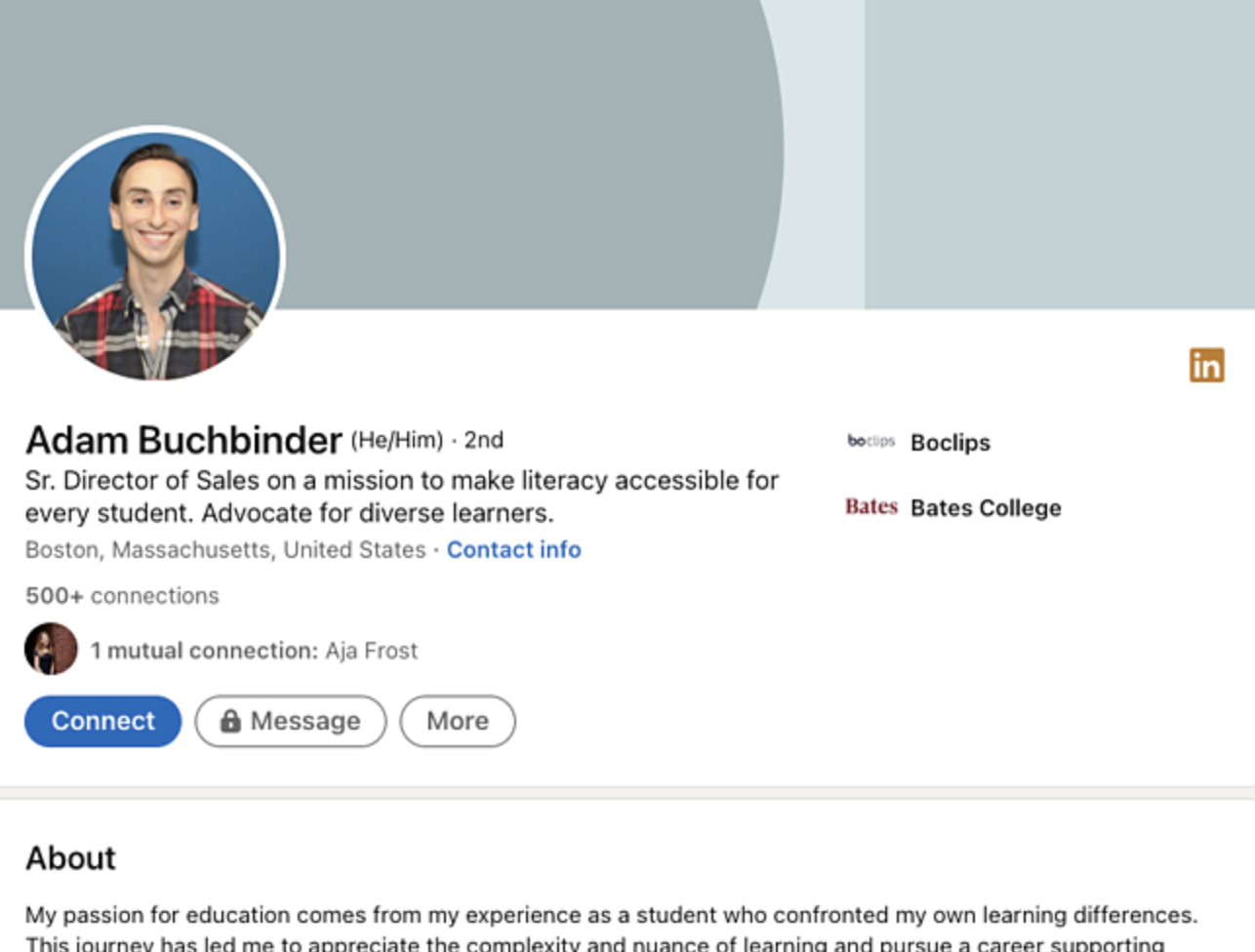
This sales professional draws potential customers in by describing his enthusiasm for "building thriving organizations in the education ecosystem" — a goal he clearly cares highly about, too.
His next line tells prospects he's interested in learning their needs, not just selling them. Then he establishes his expertise.
Our Favorite Lines
Why This Summary Works
This LinkedIn user effectively but succinctly cites a personal experience to show his reasons for supporting others who are going through the challenges he’s gone through. He also shows the breadth of his expertise and research by building upon why his product is needed in the industry.
Try It Yourself
Describe the most rewarding aspect of your job, whether that's helping small businesses go mobile or making corporations more efficient. Next, highlight why you're qualified. How many people or companies have you worked with? What are their average results? Which high-level problems are you well-equipped to solve?
2. This digital marketing expert speaks to his prospect's pain and showcases his strong copywriting skills.
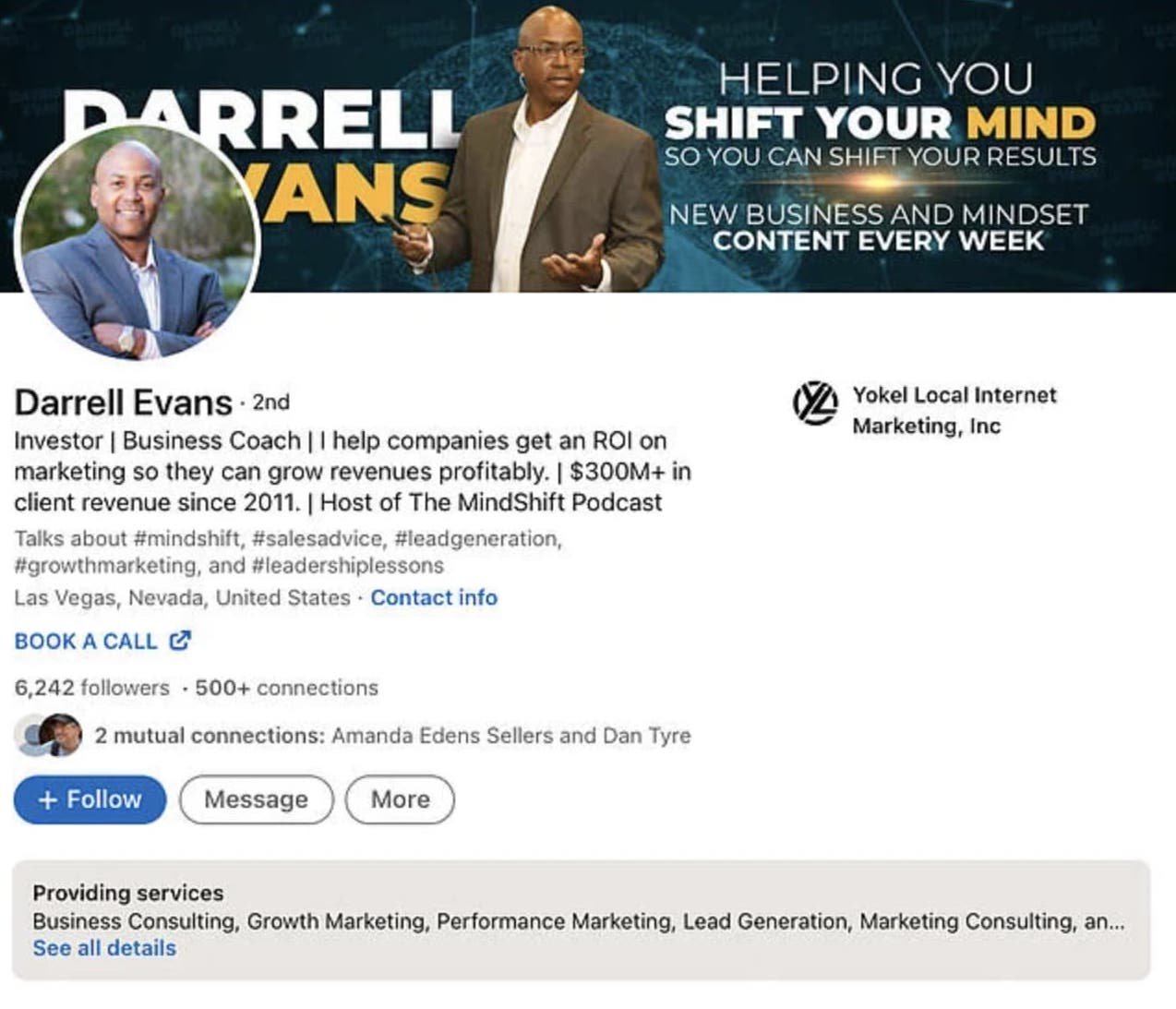
When actively connecting with prospects on LinkedIn, speak directly to them with your LinkedIn profile, but do so in a way that says you understand their struggles.
In essence, position yourself as a solution provider rather than a product seller.
This digital marketing and sales expert does this well for his marketing agency by calling out the problem. He does this before introducing himself or his solution.
Our Favorite Lines
“My team and I help growth-driven service providers, entrepreneurs, and experts add their next $1M-$10M/yr in revenue predictably and profitably.” Why we love it: Not only does this line directly identify who prospects are, but also speaks to who they want to become (“successful,” “add their next $1-$10M/yr in revenue”).
Why This Summary Works
This summary effectively hooks readers, walks them through whom the LinkedIn profile owner is, and shows them how they can benefit from reaching out to the bio owner. The writer effectively shows the ROI of working with his firm while showcasing his copywriting skills.
Try It Yourself
Write a whole introductory paragraph appealing to your customer's pains and emotions without mentioning yourself. You can offer a piece of advice or ask a question.
3. This career consultant indicates to prospects that they're in the right place.
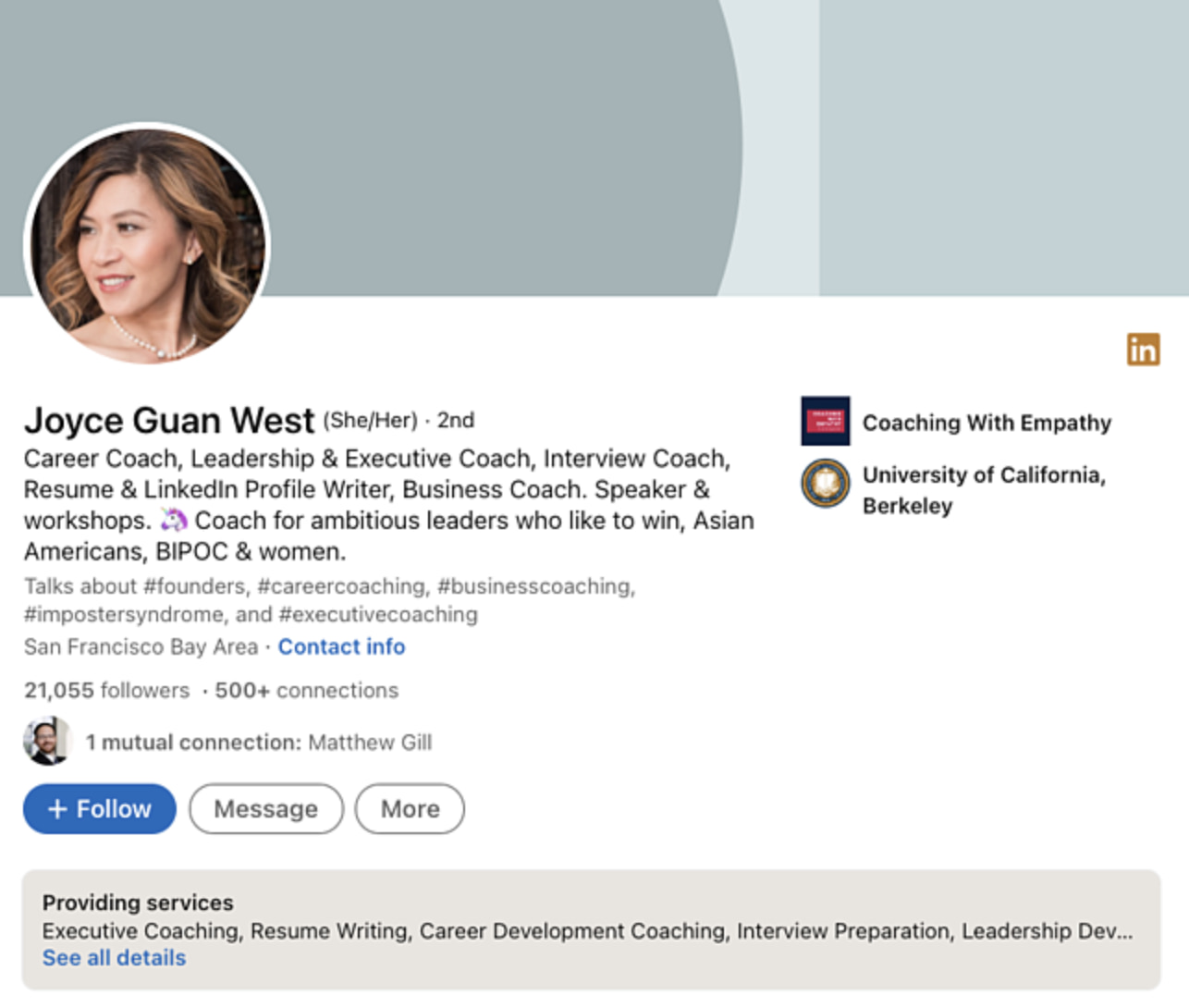
By calling out the audience you're targeting, you can get them to self-identify with your message. Specifying who you're talking to indicates to the audience that they're in the right place.
This sales consultant and career coach does this in her first sentence when she says, "[I] love being an early stage employee at fast growing and innovative companies where I can make an impact." If readers relate, they’re bound to keep reading all the way to her call-to-action at the end.
Our Favorite Lines
“I love change management, turnarounds, and strategically fixing problems and fueling growth.” Why we love it: This line effectively highlights the writer’s problem-solving mindset, which makes her a desirable candidate to work with.
“I can play a CRO role or a VP of Sales role. I have extensive experience with creating aggressive finance strategy, managing cashflow, and optimizing pricing, costs and revenues.” Why we love it: While these are technically two lines, they work well together to demonstrate the range of skills she offers her potential employers.
Why This Summary Works
This summary takes us through the various roles the consultant has taken on, all the way to her career coaching role now. Most notably, she ends with a prompt to book time on her calendar and includes a link right then and there.
Try It Yourself
Identify your buyer persona and then include a description of them in your summary. Don’t be afraid of expressing the types of roles you could play at a company, and be clear with what you want readers to do once they reach the end of the bio.
4. This salesperson uses his hobbies to look more personable and approachable.
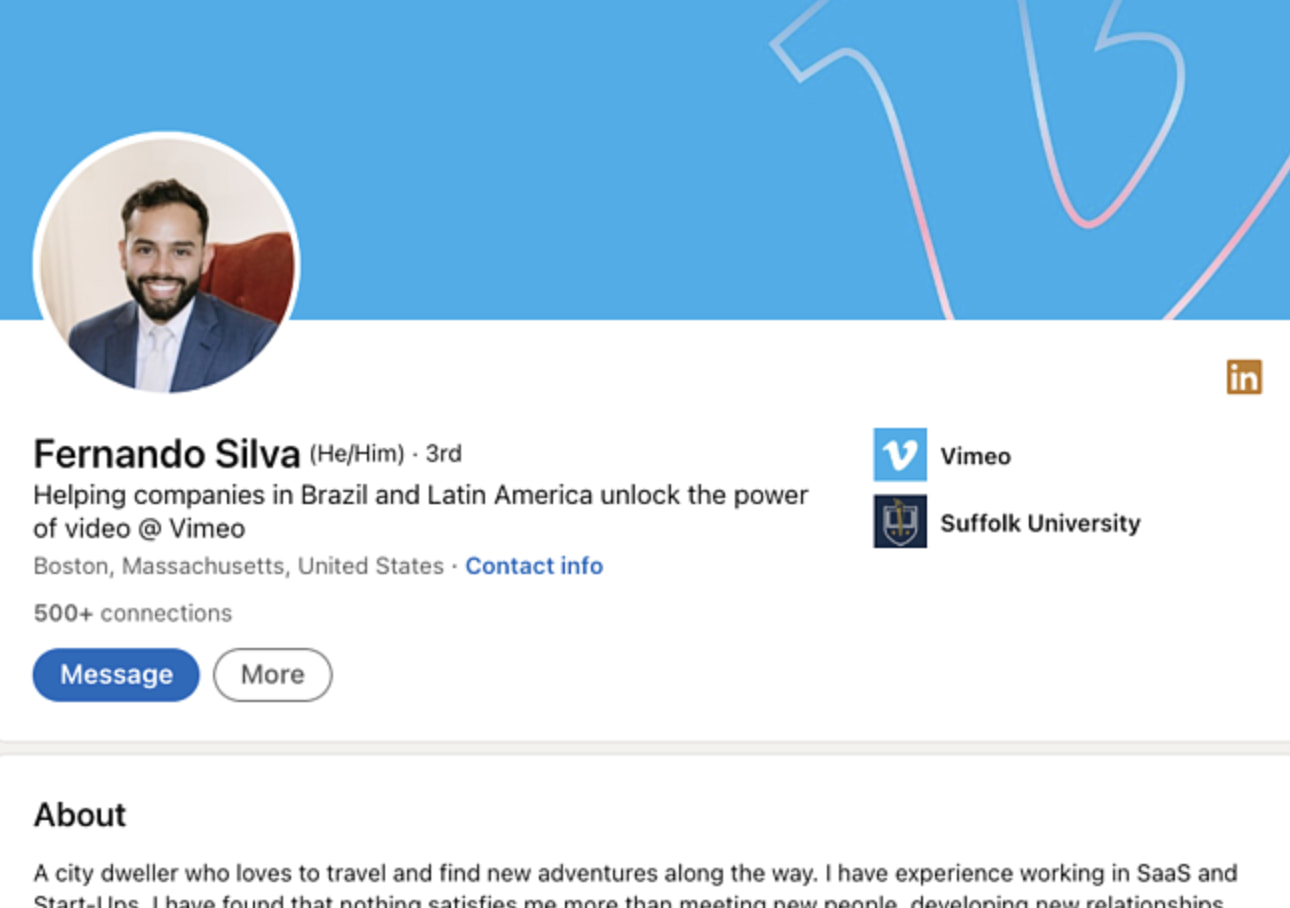
Although it might be a bit untraditional to mention your personal hobbies on your LinkedIn profile, it's a good way to make yourself more human off the bat. A prospect reading this summary might think, "Oh, I also love to travel." They'll immediately feel more connected to you.
Our Favorite Lines
“I have found that nothing satisfies me more than meeting new people, developing new relationships, solving problems, and contributing to the growth of businesses.” Why we love it: It shows the LinkedIn user’s passions at work while hinting at how he can help a potential employer or client.
Why This Summary Works
This LinkedIn summary keeps it short while incorporating the key parts of a bio: the writer’s personality, professional experience, and most desirable attributes.
Try It Yourself
List a few of the things you like to do in your free time (steering clear of anything controversial, of course). Then explain why you chose your current role and how your customers derive value.
5. This sales leader demonstrates vulnerability and communicates her passion for her mission.
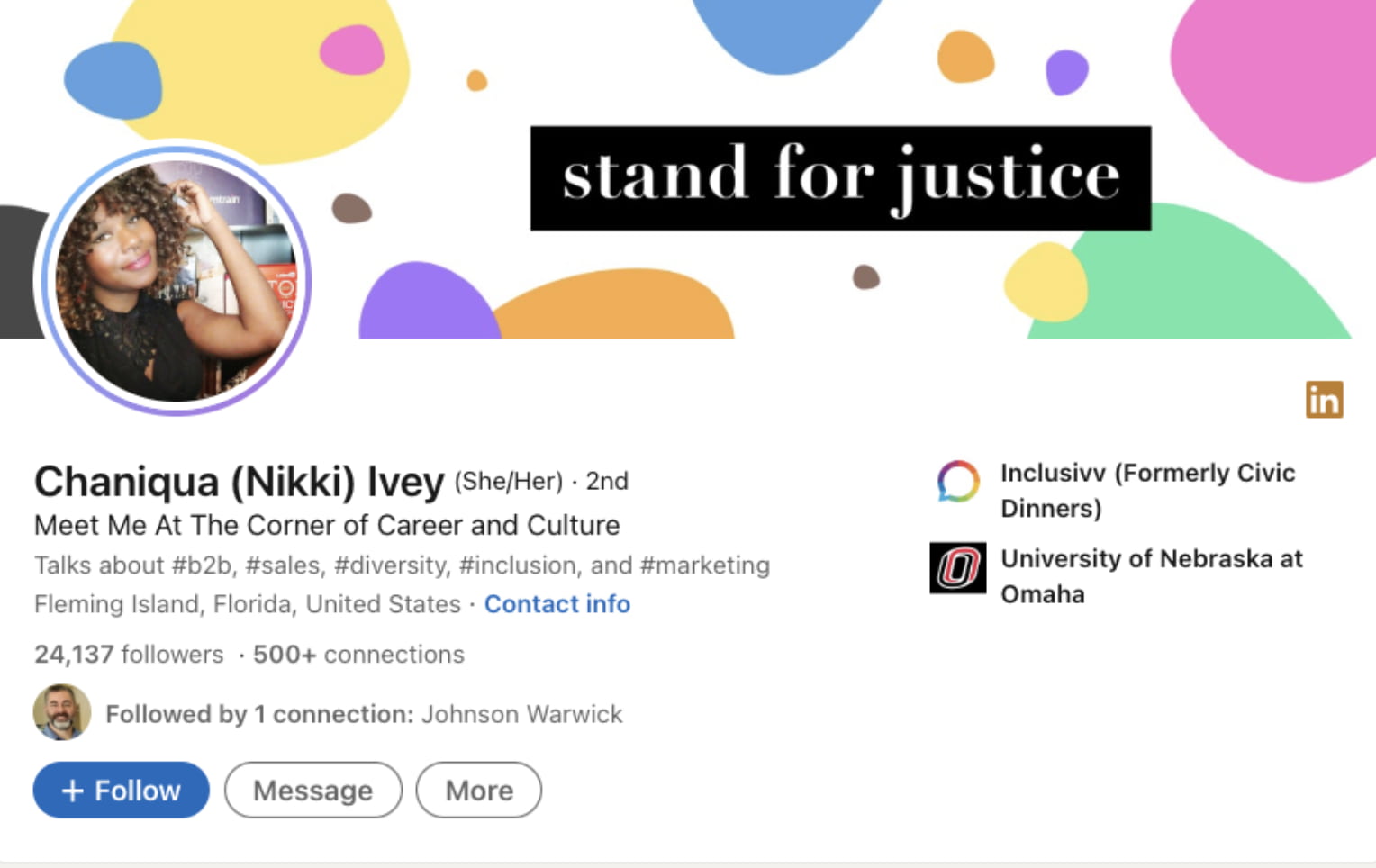
It's worth re-mentioning that stories resonate with people. While your LinkedIn profile includes where you've worked and the skills you have, your summary is prime real estate for revealing the real you behind your job history.
This leader in the B2B sales and marketing space does this by sharing her difficulty being a Black woman in sales. Being told this short story about her, we get to know her mission and values as a professional.
Our Favorite Lines
“I’d started publishing content and building communities around the deeply held belief that attracting, supporting, and retaining diverse talent is a professional and personal imperative.” Why we love it: We get to see her personal mission in a succinct and effective way, made all the more impactful by her opening line.
Why This Summary Works
The writer opens with one of the challenges she faces while working in sales, setting the stage for why she does what she does, then takes us all the way down to her mission. She closes with a call-to-action that’s impactful and welcoming.
Try It Yourself
Be vulnerable. Isolate a single moment that encapsulates you as a professional or embodies your values. Then briefly write it as if you were telling this story verbally.
6. This sales executive keeps it short and engages prospects.
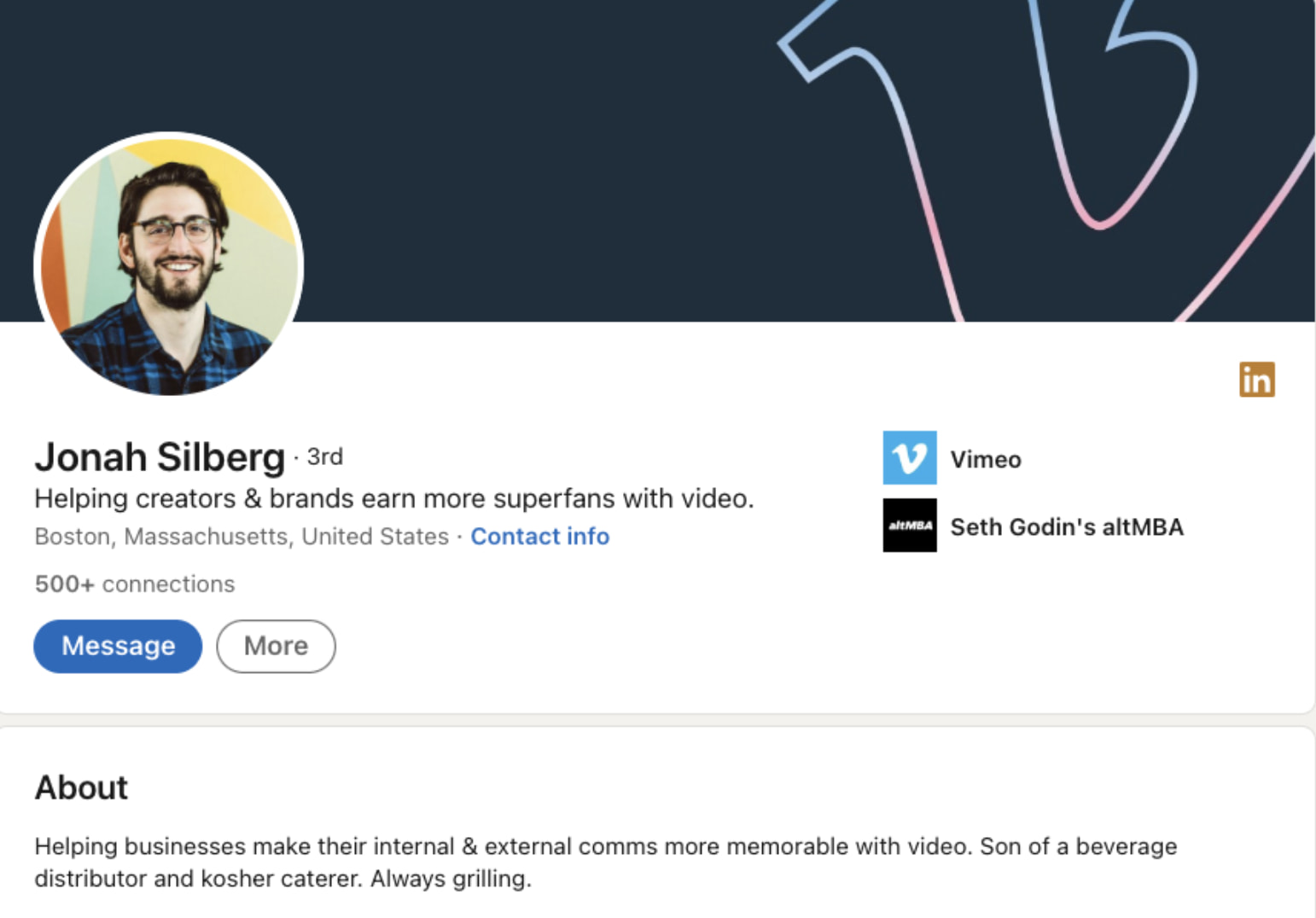
This LinkedIn bio opens with his mission: Enabling businesses to become more personable using video. His next two sentences help you get to know him on a personal level.
The summary is short enough that readers are guaranteed to finish it — but he makes every line count. He makes you interested in learning more about him.
Our Favorite Lines
“Helping businesses make their marketing & sales more human with video.” Why we love it: This line gets to the point quickly, showing the author’s mission, professional expertise, and experience.
Why This Summary Works
It’s brief, personable, and professional — all while showing the LinkedIn user’s personality. Plus, the mention of his parents is a unique touch, showing his background without much elaboration or fanfare.
Try It Yourself
In the simplest words possible, state how your company makes its customers' lives easier, better, more enjoyable, etc. Then reveal something about your background ("I was born in Spain and raised in Texas," "I've lived in Chicago my entire life," "My hometown boasts the largest Beanie Babies museum in the world") and end with "Always," "Constantly," or "Frequently" followed by your favorite thing to do ("Always reading," "Constantly cracking dad jokes," "Frequently juggling.").
7. This retired professional intrigues readers with his work history.
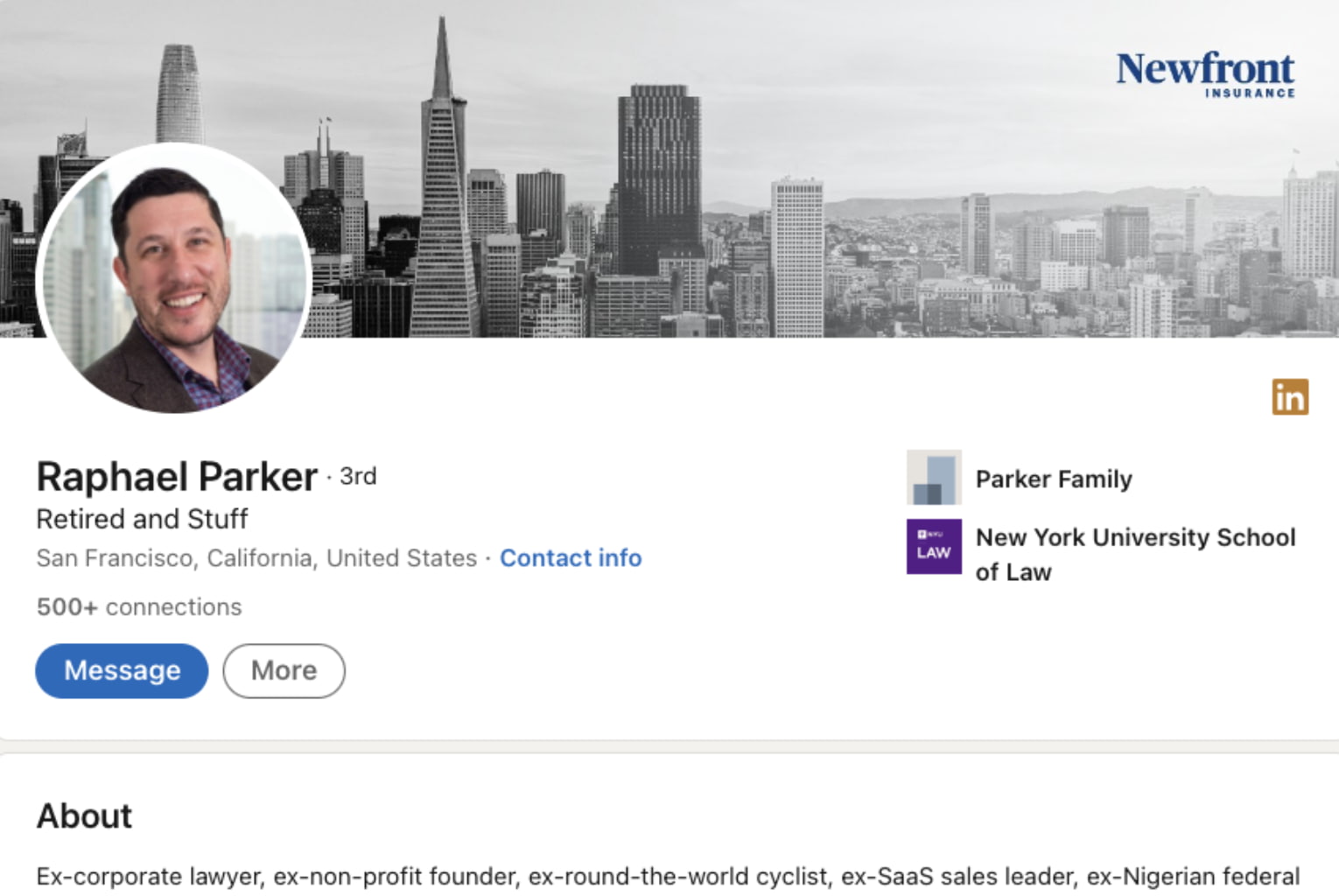
This LinkedIn user uses the same formula as the previous — but in reverse. He begins with his former jobs, which immediately tells you he's (already) had an interesting career. He then tells you what he's currently up to.
Our Favorite Lines
“Ex-corporate lawyer, ex-non-profit founder, ex-round-the-world cyclist, ex-SaaS sales leader, ex-Nigerian federal gov’t employee.” Why we love it: This opener shows how interesting the author’s career has been up until this point, making you wonder what he might be doing now (a question he answers in the last line).
Why This Summary Works
This LinkedIn bio flips expectations and delights with its one-line run-through of the author’s work history. The variety of the roles demonstrates that he can thrive at any employer if he were to ever come out of retirement. We love that he ends with his current status.
Try It Yourself
List your former jobs. If you've always been in sales, get creative. Did you ever have a lemonade stand as a child? Were you a camp counselor as a teenager? What was your college gig?
For example, you might write, "Ex-lemonade stand CEO, CMO, and COO; ex-juggler; ex-college tour guide. Currently helping prospective homeowners in Arizona find their next dream place to live. (And still juggling when asked nicely.)"
8. This sales leader gives a 360-degree view of her, her role, and her company.
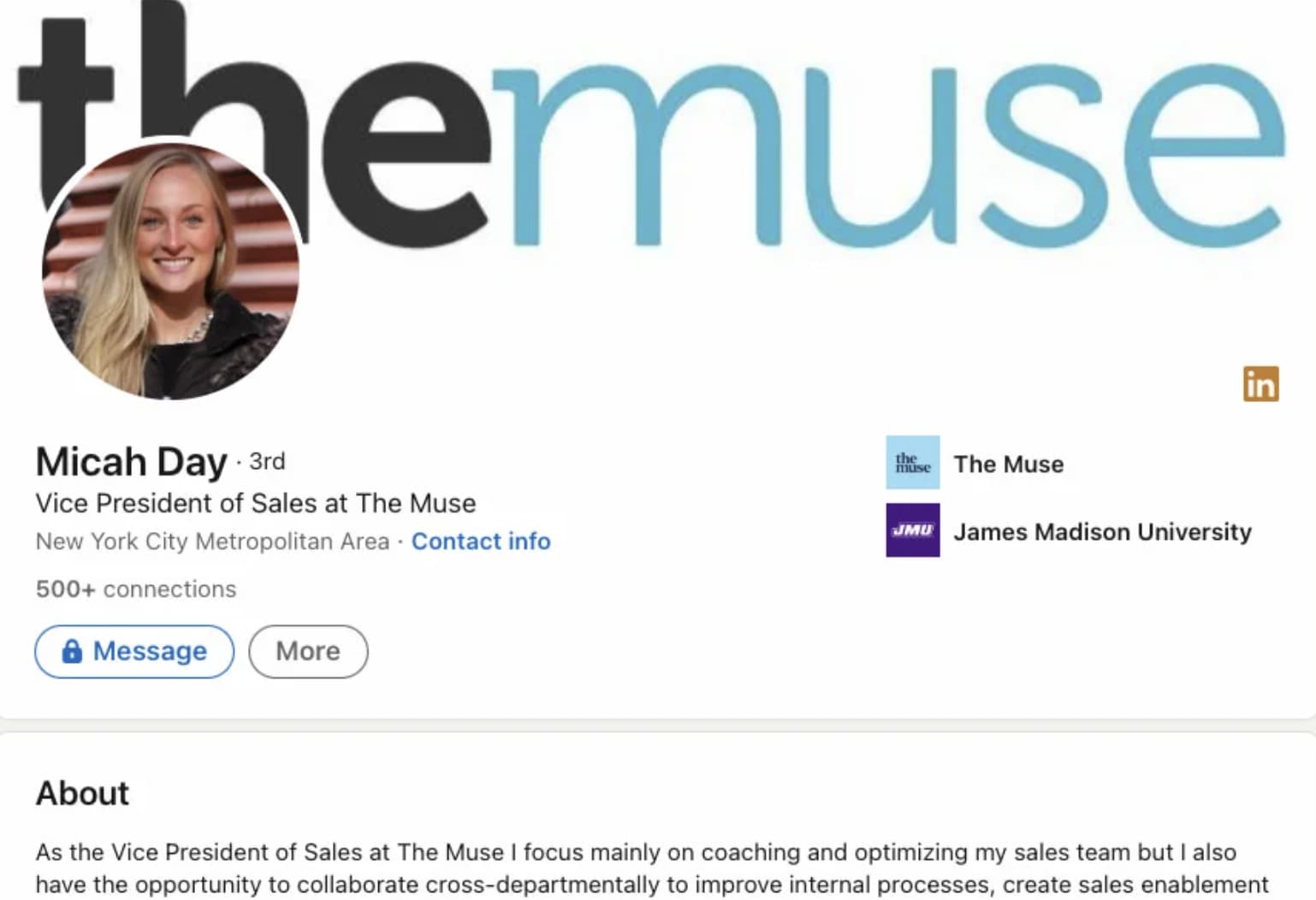
This LinkedIn summary showcases the user’s passion and enthusiasm for the role. She highlights her main responsibilities and values, tells the reader why she's proud to work at The Muse and what sets the business apart, and lists some fun facts about herself.
Our Favorite Lines
“My Muse team is brilliant, driven, and obsessed with what we are building.” Why we love it: Aside from describing herself and her role, the author gives a nod to her team — something we don’t see often in LinkedIn bios.
Why This Summary Works
This LinkedIn bio provides an in-depth look at the author’s current professional endeavors and her reasons for loving what she does. It ends on a personal note by describing her hobbies and her personality.
Try It Yourself
Explain why you're so fired up about coming into work each day. What excites you? Why do you love your company? What makes your product, culture, and/or team different from your competitors? Conclude with four or five personal tidbits about yourself.
9. This MBA graduate creates immediate credibility and lists her specialties.
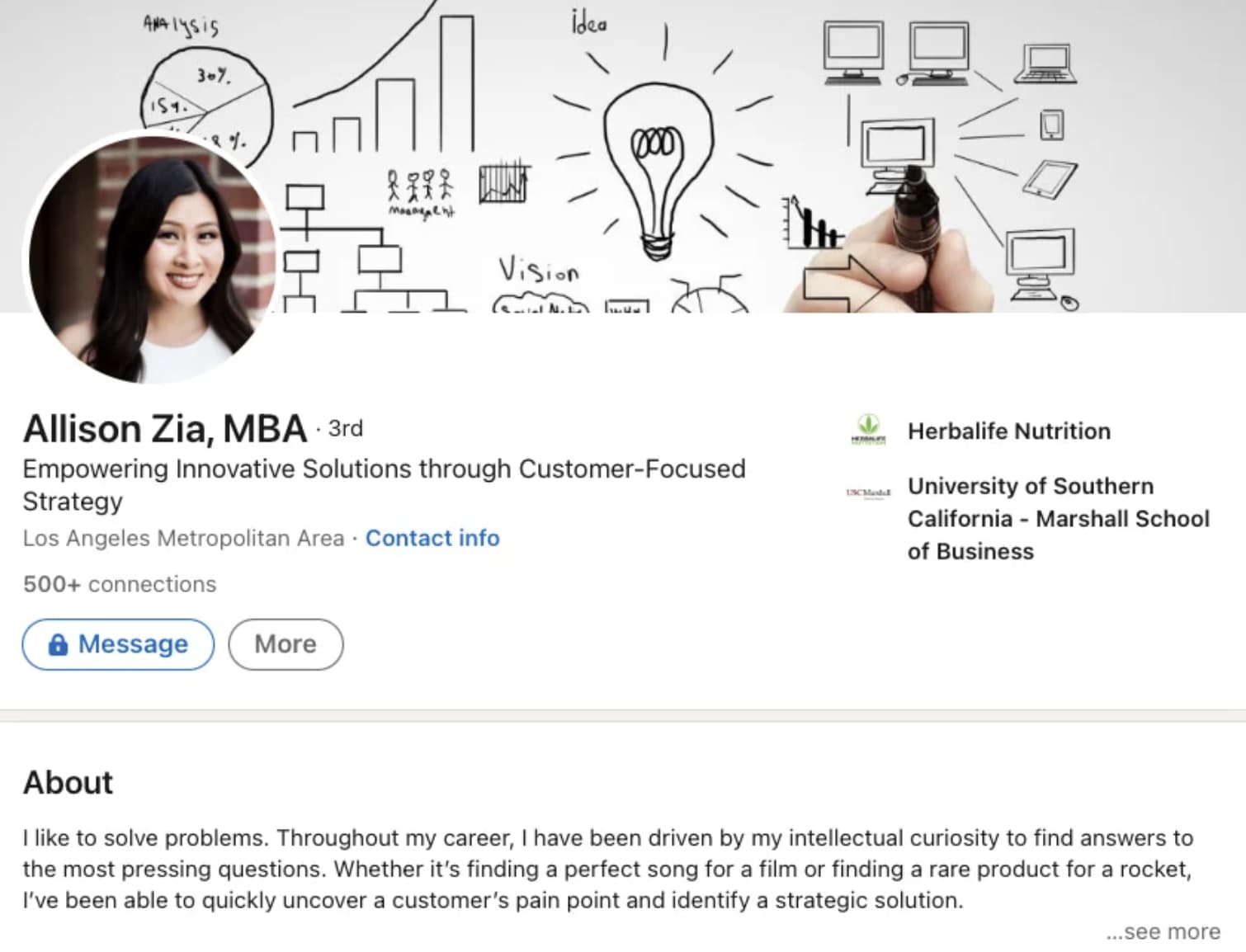
This user earns instant credibility with her LinkedIn summary.
She starts with a bold statement: "I like to solve problems." She proves it with multiple examples from her career, then spotlights her specialties. Finally, she describes a few of her interests.
Our Favorite Lines
“Whether it’s finding a perfect song for a film or finding a rare product for a rocket, I’ve been able to quickly uncover a customer’s pain point and identify a strategic solution.” Why we love it: This line shows her diversity of skills, high level of professionality, and key strengths.
Why This Summary Works
We love the bulleted list of specialties, but especially love how the author demonstrates how she’s using those skills now at her startup. She also remains personable by closing with her hobbies and an invitation to reach out to her.
Try It Yourself
Use a short, impactful one-liner to highlight why you're successful or what you're best at. Give two to four examples of how this skill or desire has manifested itself throughout your life. Discuss your areas of expertise, then wrap it up with your favorite topics of discussion.
10. This leadership consultant highlights her passions and shares how it fuels her work.
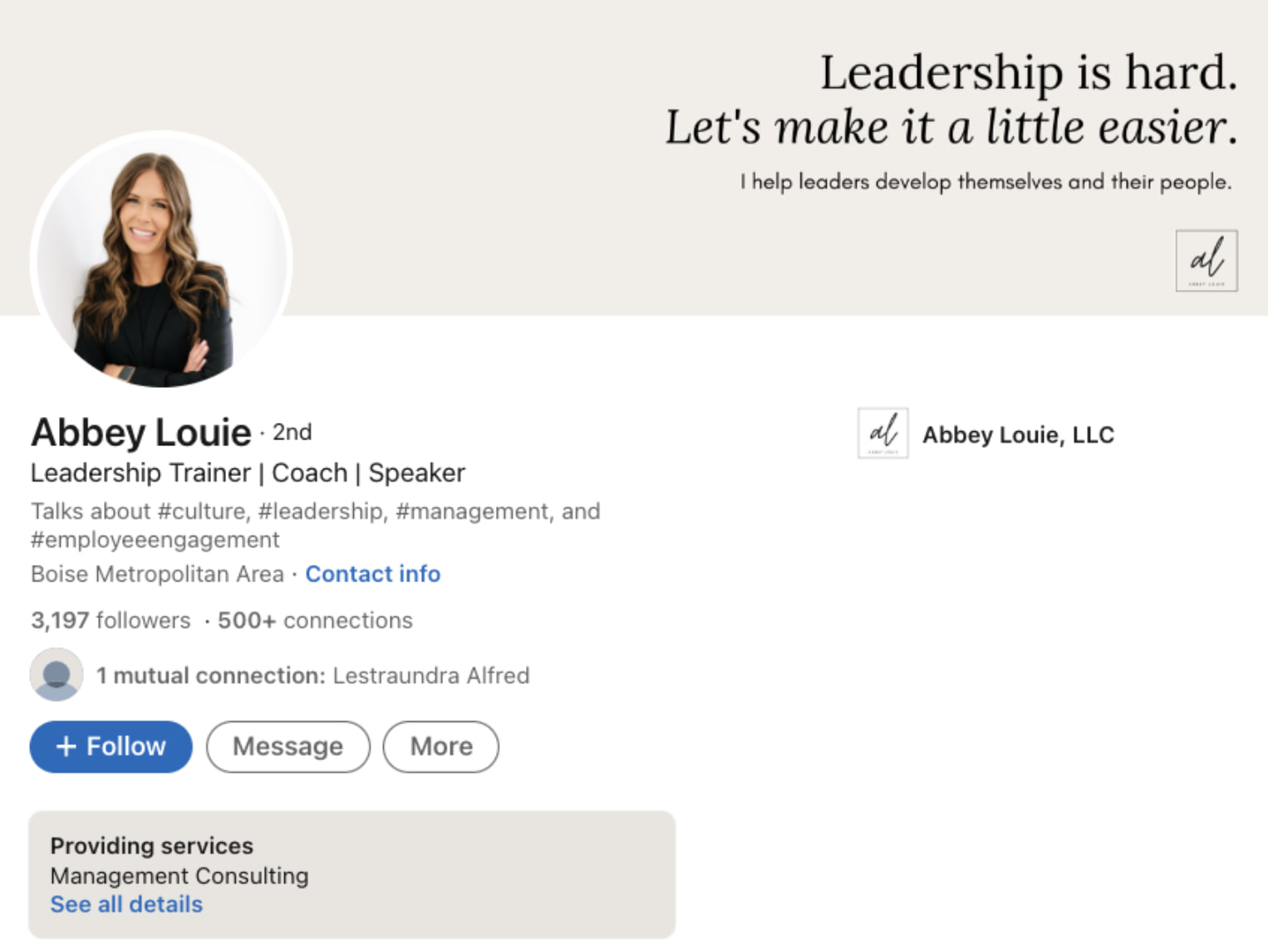
This Boise-based consultant and business owner displays her sources of expertise. She concisely shares what inspired her work, and gives potential clients a preview of the benefits they can expect from working with her.
Our Favorite Lines
“Along with my consulting work, I’m the founder of The Management Essentials, a comprehensive leadership development program for new managers.” Why we love it: While readers could potentially look at her work history to see her founder role, we love seeing it in her own words.
Why This Summary Works
The summary is connected to the author’s mission from top to bottom — you never feel like her points are disjointed or disconnected. She then leads into her current work as a founder and instructor, and ends with a list of specialties for readers to scan.
Try It Yourself
Do you have an origin story related to your career path? Share a brief description of what has inspired your work, and what makes you want to do the work you do.
11. This career consultant speaks directly to who she wants to serve.
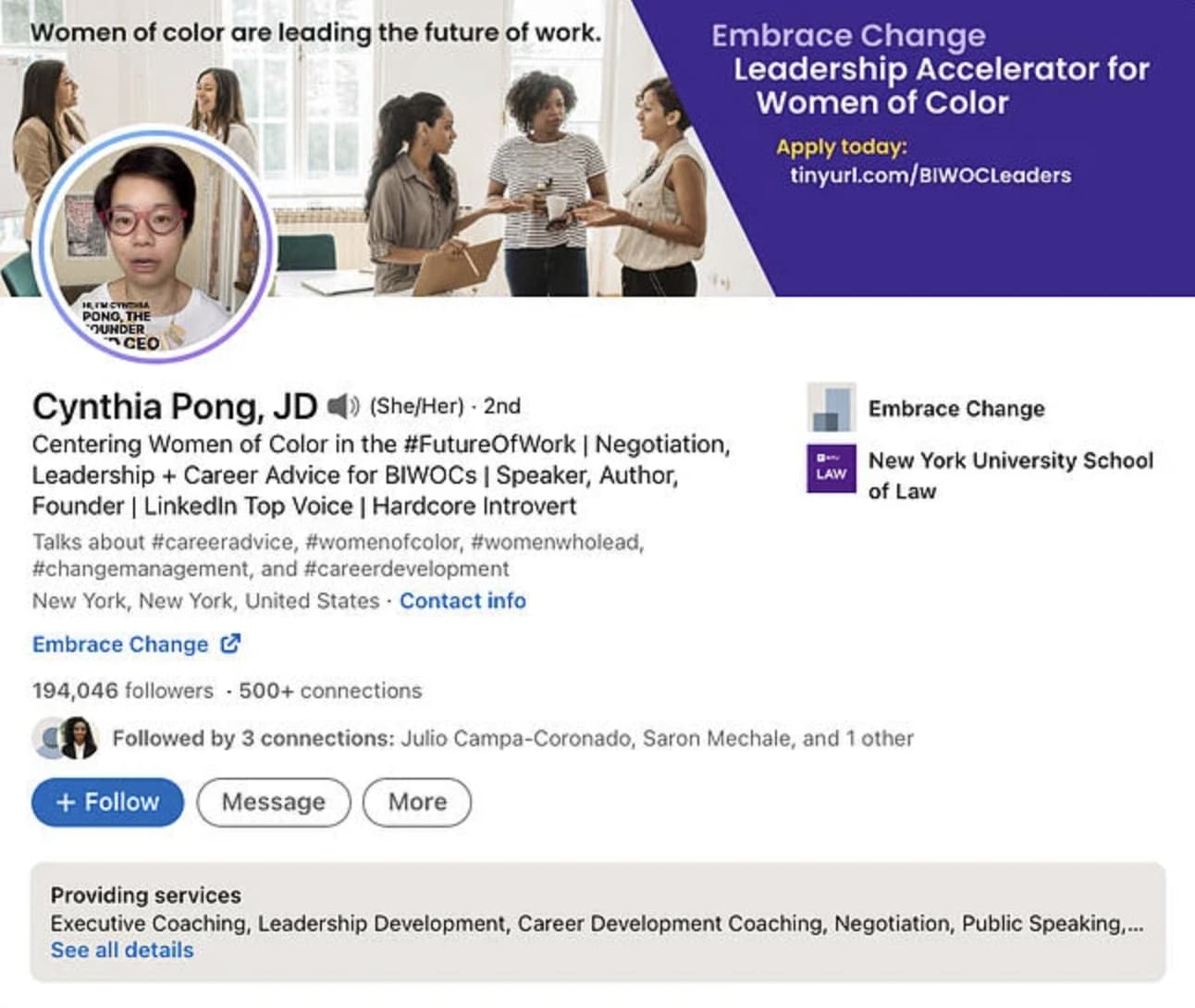
For consultants, business owners, and sales reps, speaking directly to who you want to serve in your LinkedIn summary is a smart approach to take. This career strategist and author does this masterfully in the first few sentences of her LinkedIn summary. By immediately calling in who she aims to serve, she can hook the right readers, increasing her chances of connecting with the right people.
Our Favorite Lines
“I am on a mission to get all women of color–and people of color– the money, power, and respect we deserve in the workplace.” Why we love it: The natural response to a line such as this is ‘Sign me up,’ encouraging visitors to continue reading and reach out to the author.
“I regularly partner with organizations to support BIPOC employees and leaders to success – through coaching, consulting, and workshops.” Why we love it: This line effectively summarizes what the author can do for organizations that work with her.
Why This Summary Works
The author opens with an effective and visionary hook, then describes her mission and how she works to fulfill that mission every day. She then describes what organizations and clients stand to gain from working with her.
Try It Yourself
In the first few sentences of your summary, try writing a hook that would appeal to your ideal customer or client and keep their attention.
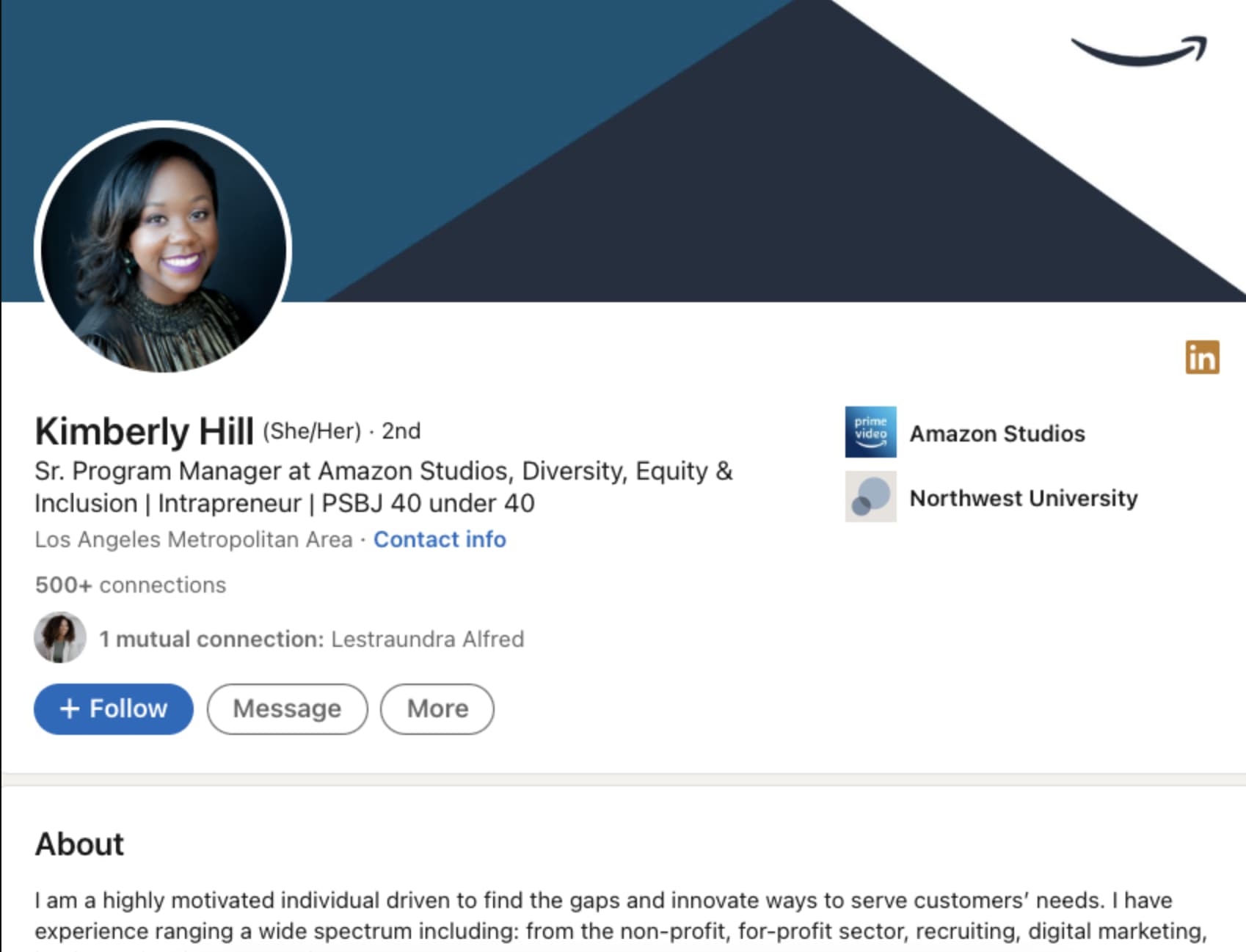
Have you received any notable awards, or had exciting features highlighting your work? Include them in your summary to build credibility. This Senior Business Development Manager shares relevant awards and accolades in her LinkedIn summary to provide valuable context around her skills and abilities.
Our Favorite Lines
“In 2018, I was selected by Jeff Bezos and his leadership team to be a recipient of Amazon’s Just Do It Award.” Why we love it: We love how this user explicitly shares her major accolades, and how she opens with the most impressive one.
“It is important for me to serve my community through non-profit work, community organizing, mentoring, and planning events.” Why we love it: Not only does this line showcase the author’s key strengths, it shows the roles an organization could hire her for.
Why This Summary Works
Your LinkedIn bio isn’t the space to be shy — and this summary exemplifies that down to the last sentence. It showcases the author’s key accomplishments without sounding arrogant, and mentions her non-profit work at length.
Try It Yourself
Highlight accolades and wins specifically related to roles you would like to be considered for.
13. This healthcare professional describes her educational background and key specialities.
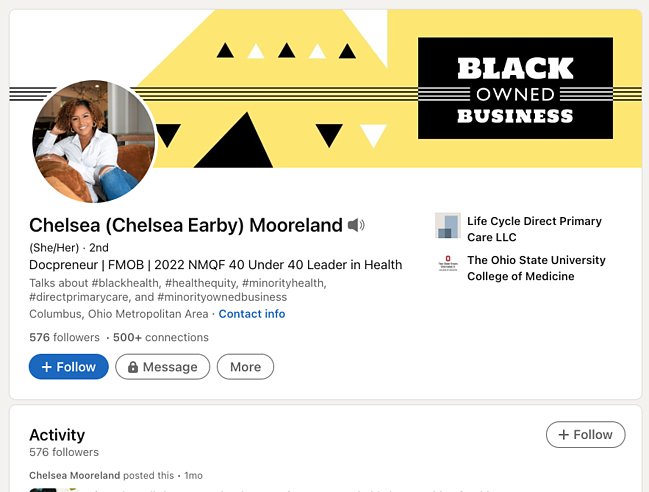
For more formal fields such as healthcare, using third-person may be warranted, and this family physician takes advantage of that opportunity. She first describes her education, which is critical in medical fields, and then ends with her key mission. Still, she shows her personality by sharing her passion for her alma mater and her nickname (“The Community Doctor”).
Our Favorite Lines
“Dr. Mooreland received her Doctorate from The Ohio State University (Go Bucks!) where she was inducted into the Gold Humanist Honor Society and selected as a National Health Service Corp Scholar.” Why we love it: In this line, the author effectively shares her educational background, her personality, and her key accolades.
“Dubbed the ‘The Community Doctor,’ Dr. Mooreland founded Life Cycle DPC to be fully committed to serving well, free from meaningless boundaries and unrelenting paperwork, to engage and be fully present in the community with you and your family.” Why we love it: This line shows Dr. Mooreland’s pivotal role in her community and addresses the reader directly.
Why This Summary Works
This formal LinkedIn bio front-loads the author’s educational background, which is key in industries such as healthcare, and adds a personal touch by emphasizing the importance of her work in the community.
Try It Yourself
Play with the structure of your LinkedIn bio, depending on your industry. If you’re an entrepreneur, you might start with your most recent startup; if you’re a lawyer, you might begin with your most important practice areas and your case record.
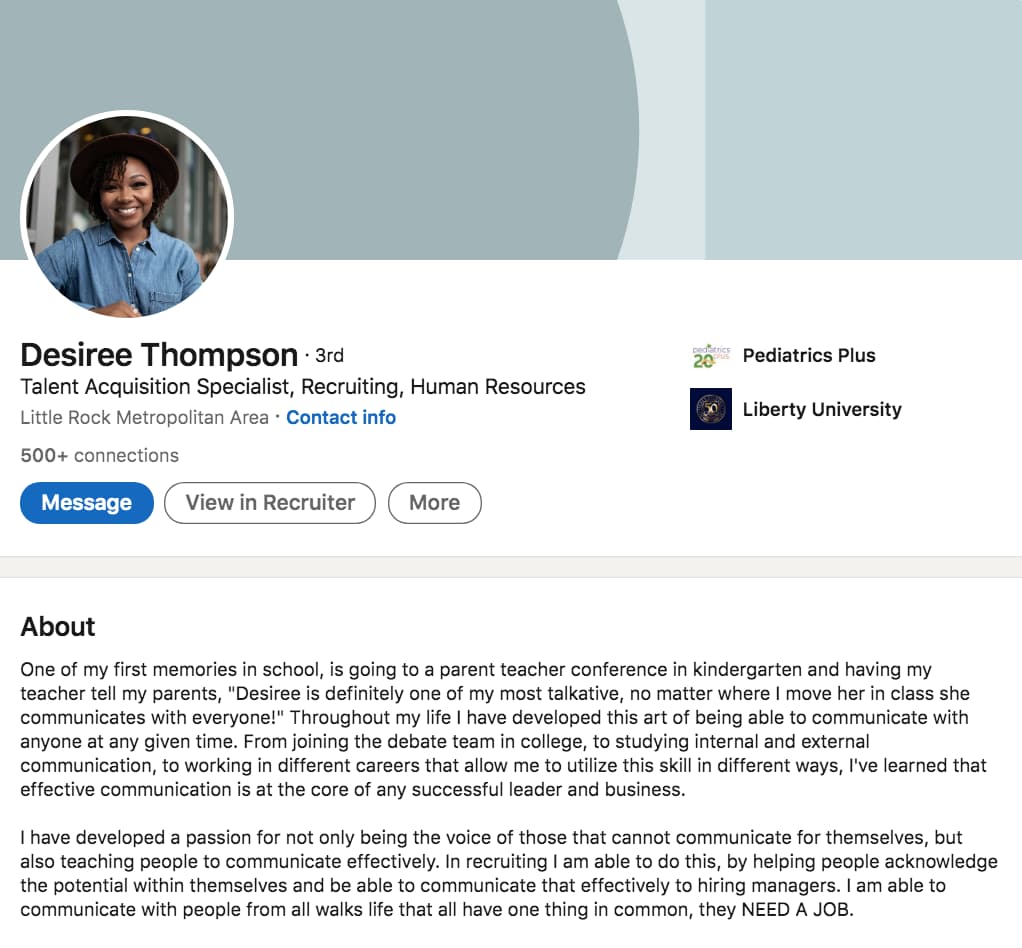 As you write your LinkedIn summary, consider how your past experiences have led you to your current position. For instance, maybe your summer job as a teenager sparked a passion for sales, or your degree in Film informs how you shoot social media marketing videos.
As you write your LinkedIn summary, consider how your past experiences have led you to your current position. For instance, maybe your summer job as a teenager sparked a passion for sales, or your degree in Film informs how you shoot social media marketing videos.
Our Favorite Lines
"One of my first memories is going to a parent-teacher conference in kindergarten and having my teacher tell my parents, “Desiree is definitely my most talkative, no matter where I move her in class she communicates with everyone!" Why we love it: We're not sure where the story is going at this point, but the hook is intriguing enough to continue reading.
Why This Summary Works
This bio is far from cold or stuffy. The writer adds warmth by presenting personal tales that explain her journey to present day. Further, the same theme echos throughout the entire story (the importance of communication).
Try It Yourself
Weave a common thread through your academic and professional experiences (if one exists). Leverage the power of storytelling to bring your bio to life and add a touch of warmth.
15. This sales leader intrigues readers with her local know-how.
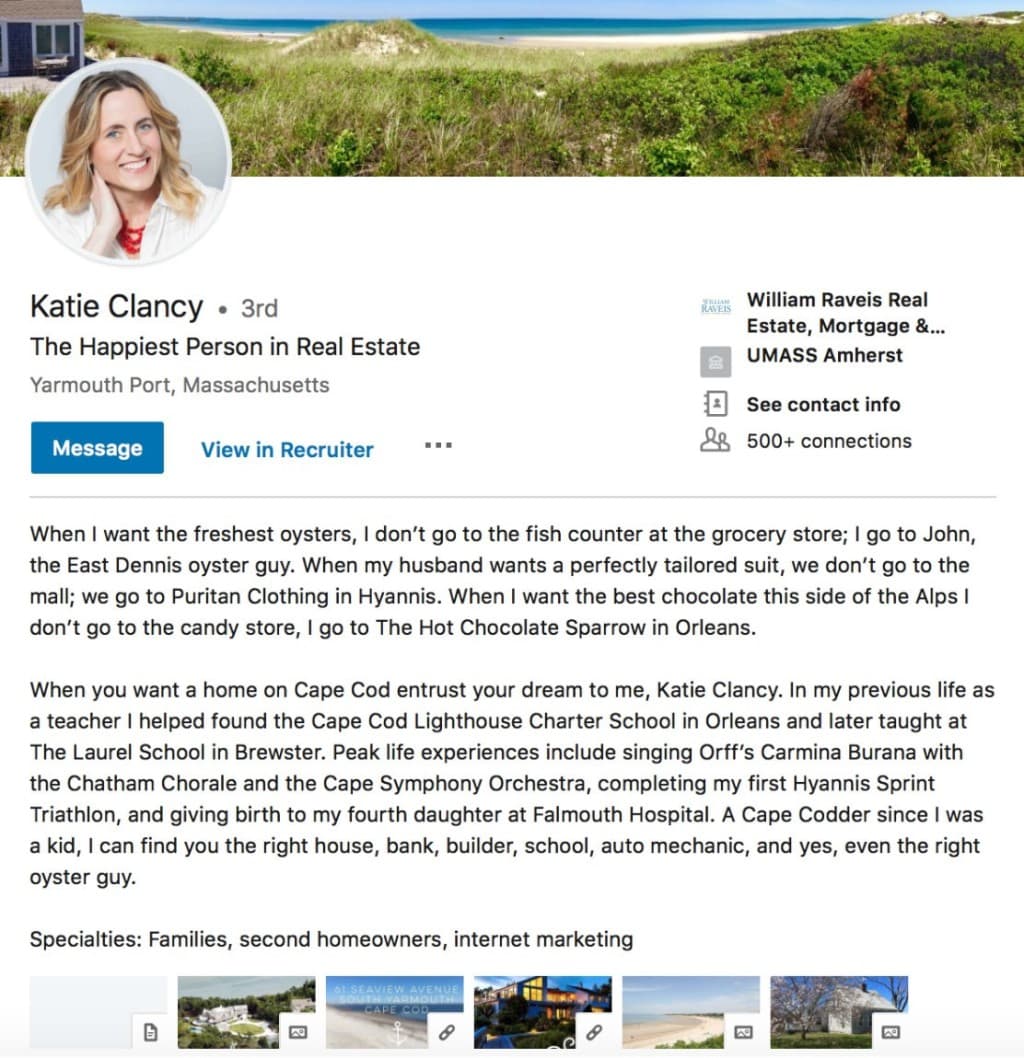
Katie does a great job underscoring her knowledge of Cape Cod with a compelling story about her community. She positions herself as the "go to" person for recommendations in the area, from oysters to suits. It's her passion and enthusiasm that lets real estate buyers and sellers know she's deeply connected to the local area.
Our Favorite Lines
"When I want the freshest oysters, I don''t go to the fish counter at the grocery store; I go to John, the East Dennis oyster guy." Why we love it: From the first sentence, the author is flexing her local knowledge, which is important in real estate. We also love this intriguing hook.
"A Cope Codder since I was a kid, I can find you the right house, bank, builder, school, auto mechanic, and yes, even the right oyster guy." Why we love it: Sometimes it's uncomfortable to tout our expertise. This author uses storytelling to boast her authority without it being the main focus.
Why This Summary Works
Let's face it: it's hard to write about yourself and your accomplishments. The author hits the right note by folding her local expertise and know-how into a delightful story about her community in Cape Cod.
Try It Yourself
If you're in real estate, it's important to flex your knowledge about the area. After all, real estate is a local game. Make sure to identify yourself as an expert and enthusiastic fan of where you live and work.
LinkedIn Summary Template
Below is a basic template you can use to customize with your own details for a succinct and effective LinkedIn summary. Make sure to add personal details to make it memorable for readers:
LinkedIn Summary Sample Templates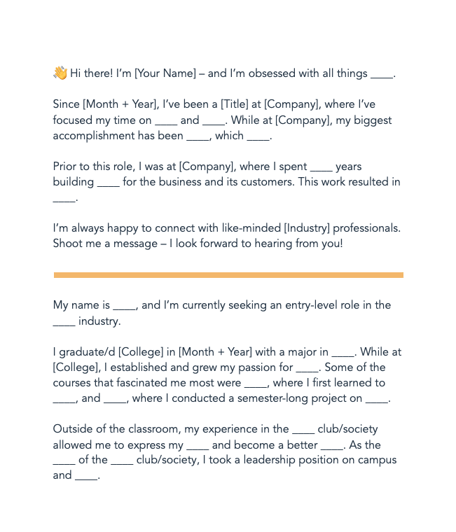
Stand Out with an Exceptional LinkedIn Summary
With these LinkedIn summaries to draw on, you should have plenty of ideas and inspiration for your own description. Make it personal, unique, and engaging — and prospects and potential employers will feel like they know you already.
Editor's note: This post was originally published in August 2017 and has been updated for comprehensiveness.
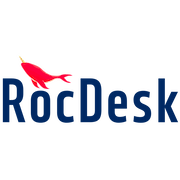


























 As you write your LinkedIn summary, consider how your past experiences have led you to your current position. For instance, maybe your summer job as a teenager sparked a passion for sales, or your degree in Film informs how you shoot social media marketing videos.
As you write your LinkedIn summary, consider how your past experiences have led you to your current position. For instance, maybe your summer job as a teenager sparked a passion for sales, or your degree in Film informs how you shoot social media marketing videos. 

